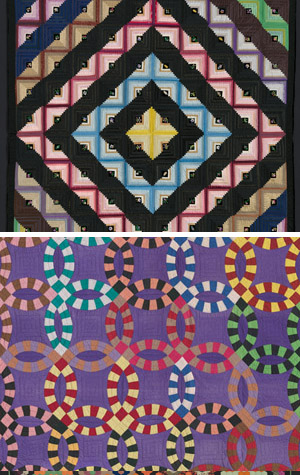Quilts and Color on View at the MFA
A kaleidoscopic feast for the eyes

Visiting Quilts and Color, the new show at the Museum of Fine Arts, is like holding a kaleidoscope up to your eye. The 59 eye-popping quilts on display here—all made by American women between the early 19th and mid-20th century—is a masterful example of how quilt makers over the centuries have employed color to dramatic, sometimes startling, effect. The exhibition is drawn from the collection of Gerald Roy and the late Paul Pilgrim, who began buying quilts in the 1960s. Trained artists and designers, the couple initially sought out quilts with unique designs that echoed the work of abstract expressionist painters. As their collection grew and their knowledge of American quilts deepened, they broadened their collecting to include more traditional designs, some of which are included in this show.
The quilts are ingeniously grouped into sections that illustrate different principles of color theory—vibrations, variations, mixtures, contrasts, gradations, and optical illusions. Structuring the show this way enables the viewer to see the quilts in a completely different light: each of these quilt makers had a commanding understanding of color theory. One early 20th-century Double Irish Chain quilt, attributed to Emma Gingerich, is a wonderful example of how a quilt maker can create a blurring, or blending, of color—what’s referred to as a “mixture” effect—by placing certain colors together. The combination of patches of blue-green and purple (colors adjacent to each other on the color wheel) in the quilt make the blocks blur. The background pulls the blue out of the purple, giving the quilt an almost reddish tint. The effect varies as the eye moves across the quilt. The spectacular Sunburst quilt, made by Mrs. Ephraim Scott in 1856, offers another example of mixture—the red points of the sunburst combine with the yellow diamonds in such a way that the eye mixes them into orange.
One series of quilts explores color gradations. In Log Cabin, Barn Raising Variation quilt, 1879, Mrs. Herrick, the first quilt acquired by Pilgrim and Roy, the quilt maker used concentric squares made from progressively darker version of related colors. The alternating bright and dark diamonds recall the play of light and shadow across a barn’s rafters and floor during construction. It’s easy to see how this quilt could make a collector out of anyone.
Another aspect of the show displays how some quilters employed variation of classic forms. In a Pennsylvania quilt from the 1920s, Log Cabin Barn Raising Variation, the artist has employed a fractured pattern and plaid fabric centers, which replace the traditional red centers.

One of the show’s most arresting sections is a series of quilts that offer striking optical illusions through their use of color and design. A superb Field of Diamonds quilt, circa 1860, offers plenty of surprises up close. The quilt maker has arranged hundreds of hexagonal patches in clusters of color that allow new patterns to emerge. Look closely and you’ll see diamonds, stars, and tumbling cubes.
The exhibition’s last section is fittingly called “Singular Visions”—quilts so original as to defy categorization. One of the most vivid, Double Wedding Ring quilt, Missouri, about 1940, was made by an unknown African American quilter who has taken the traditional double wedding ring form and turned it into something altogether original: instead of designing rings of similar colors (usually pastels), she has selected colors at the other end of the spectrum—employing solids, prints, plaids, and stripes—set against a purple background.
In text accompanying the show, Roy notes that he and Pilgrim began collecting because they “shared a passion, appreciation, and a familiarity with quilts that we felt were being ignored.” This show goes a long way to address that, making a compelling case for why American quilts deserve the same respect as painting, printmaking, and sculpture.
Quilts and Color is on view at the Museum of Fine Arts, 465 Huntington Ave., Boston, through Sunday, July 27. The museum is open Mondays, Tuesdays, Saturdays, and Sundays from 10 a.m. to 4:45 p.m. and Wednesday through Friday from 10 a.m. to 9:45 p.m. Admission is free for members or students with a BU ID; $25 for adults; $23 for seniors and students 18 and over; free for children ages 6 and under; free for youth 7 to 17 on weekdays after 3 p.m., weekends, and Boston public school holidays (otherwise $10). The museum is free to the public on Wednesday evenings. By public transportation, take an MBTA Green Line E trolley or the number 39 bus to the Museum of Fine Arts stop or the Orange Line train or bus routes 8, 47, or C2 to the Ruggles stop.
Comments & Discussion
Boston University moderates comments to facilitate an informed, substantive, civil conversation. Abusive, profane, self-promotional, misleading, incoherent or off-topic comments will be rejected. Moderators are staffed during regular business hours (EST) and can only accept comments written in English. Statistics or facts must include a citation or a link to the citation.